状语从句
图片预览

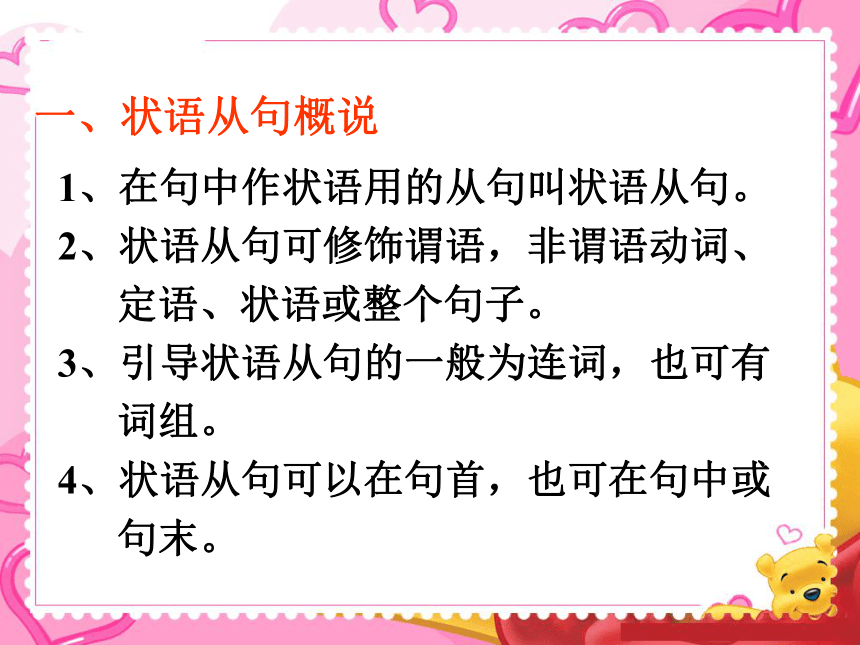
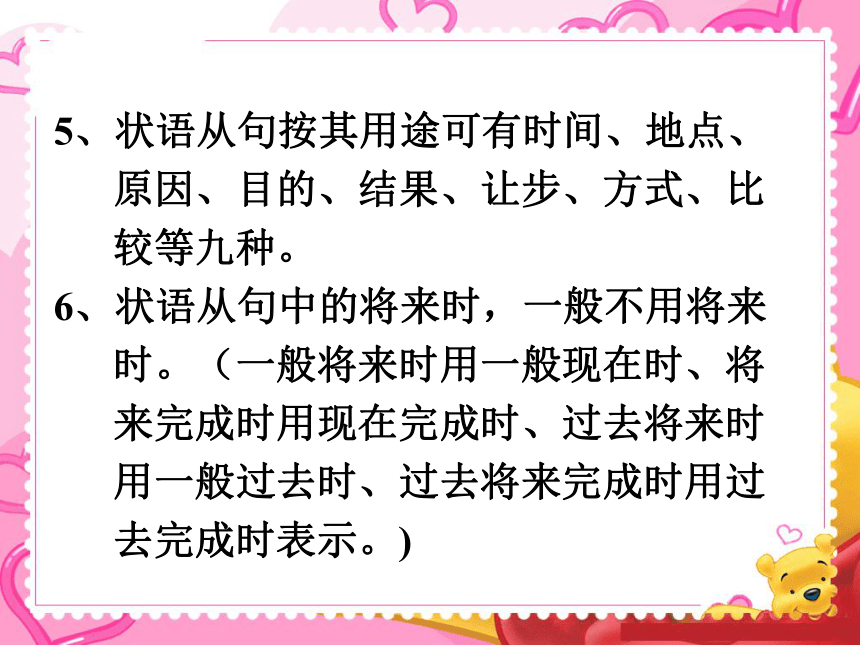
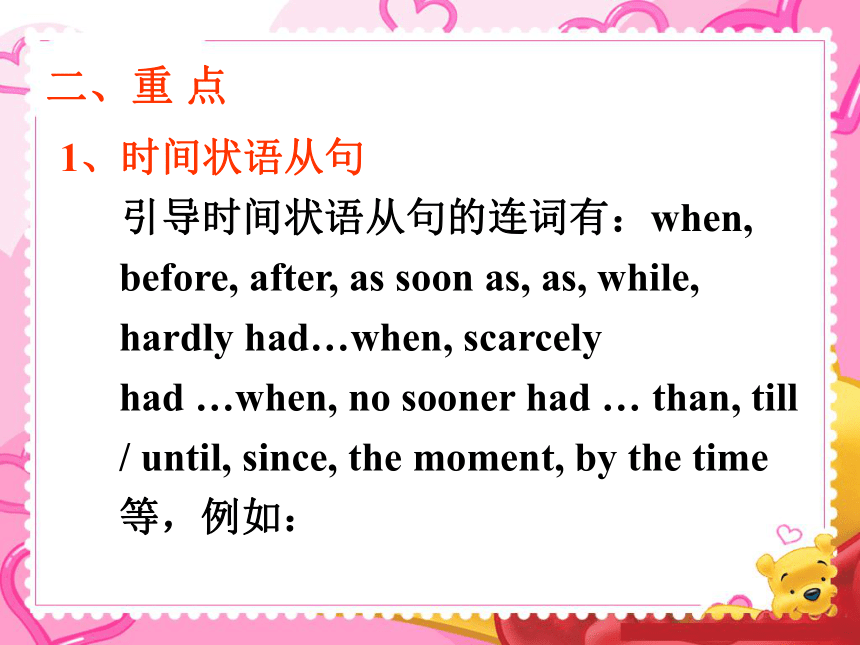

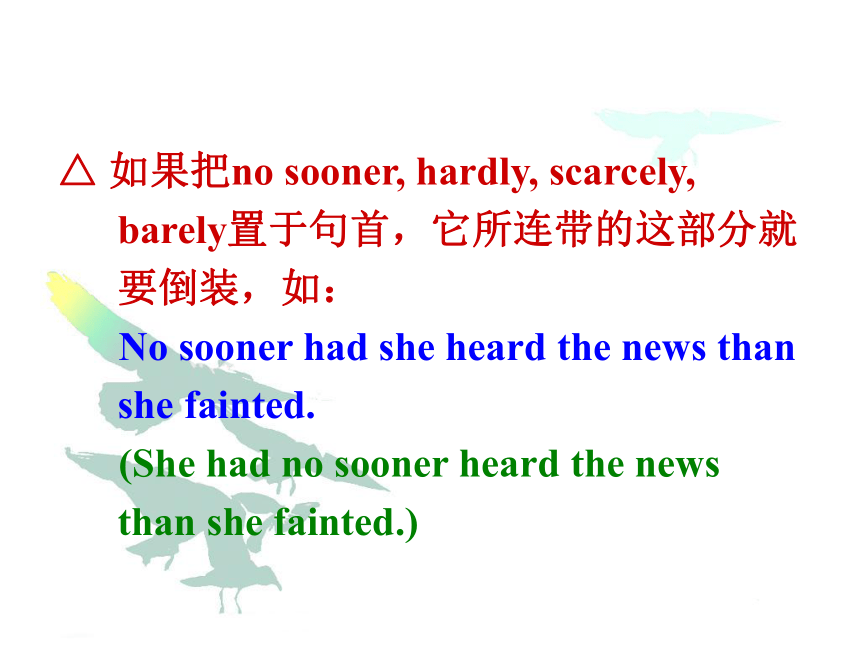
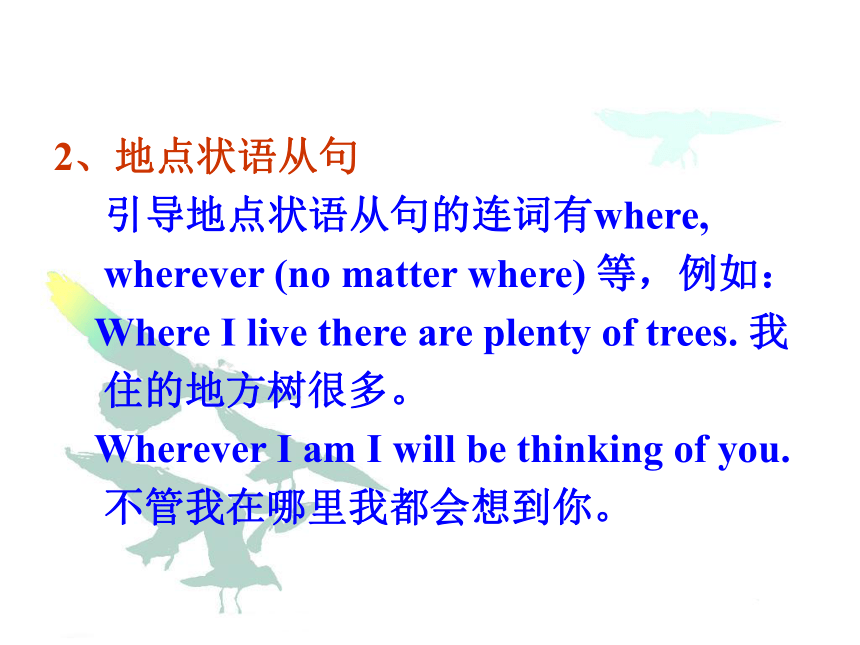
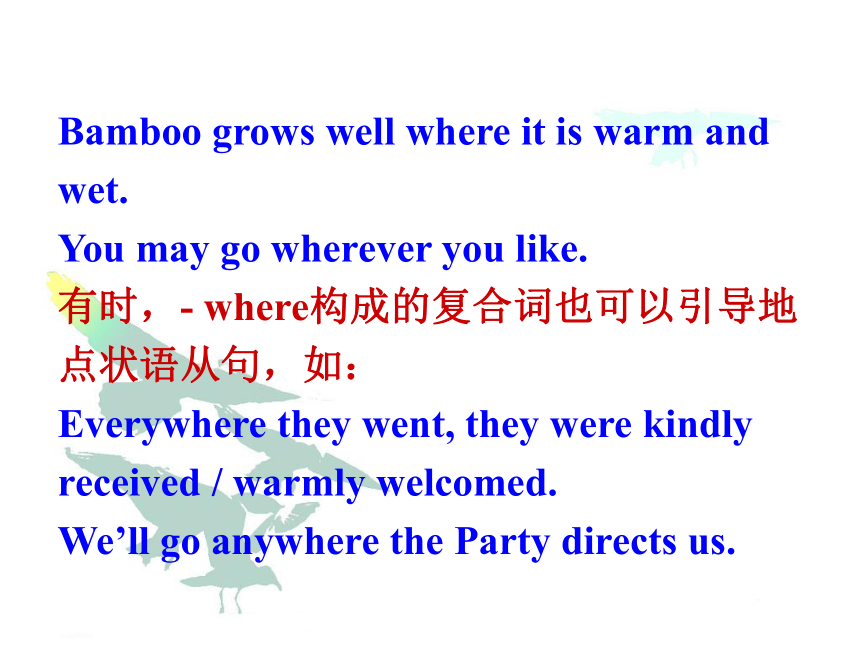
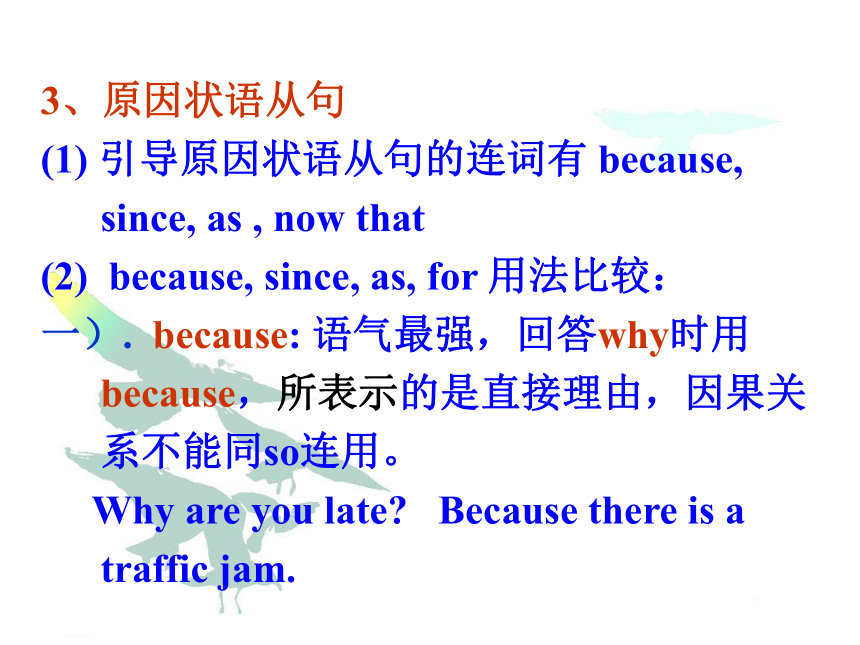
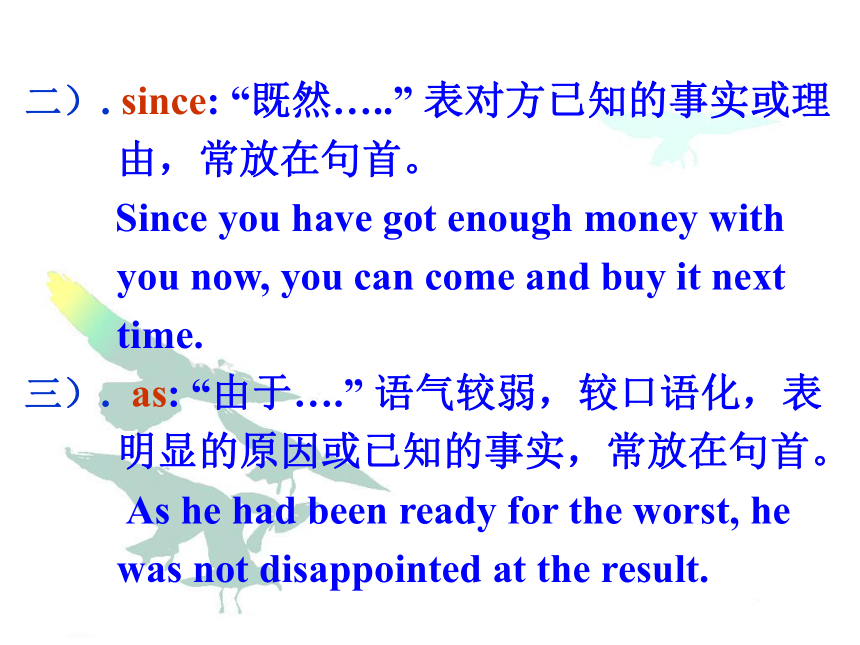

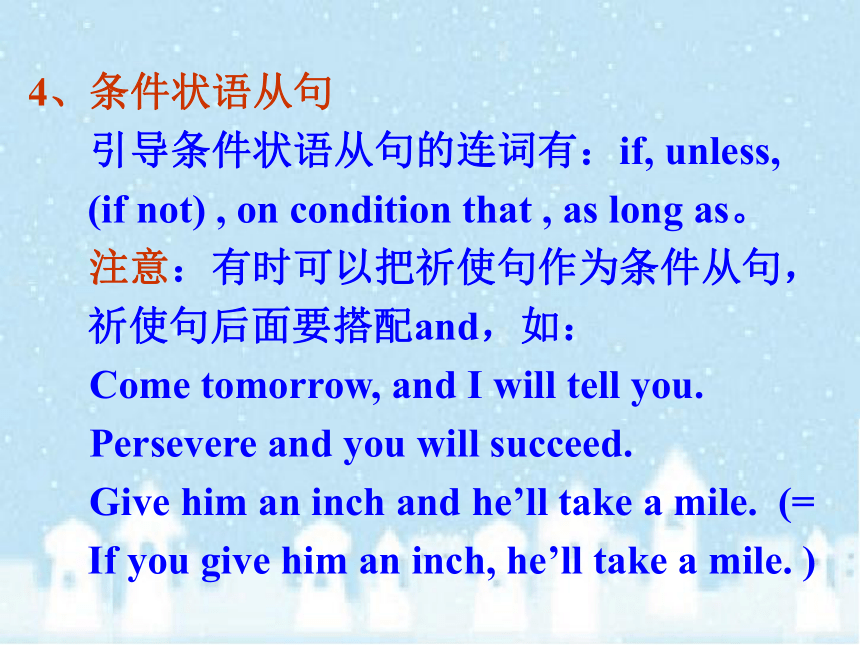
文档简介
课件41张PPT。英语总复习语法系列训练状语从句导学一、状语从句概说1、在句中作状语用的从句叫状语从句。
2、状语从句可修饰谓语,非谓语动词、定语、状语或整个句子。
3、引导状语从句的一般为连词,也可有词组。
4、状语从句可以在句首,也可在句中或句末。 5、状语从句按其用途可有时间、地点、原因、目的、结果、让步、方式、比较等九种。
6、状语从句中的将来时,一般不用将来时。(一般将来时用一般现在时、将来完成时用现在完成时、过去将来时用一般过去时、过去将来完成时用过去完成时表示。) 二、重 点 1、时间状语从句
引导时间状语从句的连词有:when, before, after, as soon as, as, while, hardly had…when, scarcely had …when, no sooner had … than, till / until, since, the moment, by the time 等,例如:Whenever we met with difficulties, they came to help us.
I got in touch with him immediately I received his letter.
My sister came directly she got my message.
Every time I catch a cold, I have pain in my back.△ 如果把no sooner, hardly, scarcely, barely置于句首,它所连带的这部分就要倒装,如:
No sooner had she heard the news than she fainted.
(She had no sooner heard the news than she fainted.)2、地点状语从句
引导地点状语从句的连词有where, wherever (no matter where) 等,例如:
Where I live there are plenty of trees. 我住的地方树很多。
Wherever I am I will be thinking of you. 不管我在哪里我都会想到你。Bamboo grows well where it is warm and wet.
You may go wherever you like.
有时,- where构成的复合词也可以引导地点状语从句,如:
Everywhere they went, they were kindly received / warmly welcomed.
We’ll go anywhere the Party directs us.3、原因状语从句
(1) 引导原因状语从句的连词有 because, since, as , now that
(2)??because, since, as, for 用法比较:
一). because: 语气最强,回答why时用because,所表示的是直接理由,因果关系不能同so连用。
Why are you late? Because there is a traffic jam.二). since: “既然…..” 表对方已知的事实或理由,常放在句首。
Since you have got enough money with you now, you can come and buy it next time.
三). as: “由于….” 语气较弱,较口语化,表明显的原因或已知的事实,常放在句首。
As he had been ready for the worst, he was not disappointed at the result.四). for是一个等立连词,连接的是两个并列的分句,其他三个引导的是状语从句;for不能放在句首。
It must have rained last night, for the ground is wet.4、条件状语从句
引导条件状语从句的连词有:if, unless, (if not) , on condition that , as long as。
注意:有时可以把祈使句作为条件从句,祈使句后面要搭配and,如:
Come tomorrow, and I will tell you.
Persevere and you will succeed.
Give him an inch and he’ll take a mile. (= If you give him an inch, he’ll take a mile. )但:
当表示否定的条件时,可用连词or 或otherwise, 如:
Make up your mind, or you’ll miss the chance.
Start at once, or / otherwise you’ll miss the train. (= If you don’t start at once, …) (= Unless you start at once, you’ll miss the train.)5、目的、结果状语从句
(1)引导目的状语从句的连词有so that, in order that;
引导结果状语从句的连词有so….that, such….that
(2)….so that…., in order that…..引导目的状语从句时,从句中常有can, could, may, might, would(3)so + 形容词/副词/分词 + that引导结果状语从句
such + (形容词) + 名词 + that引导结果状语从句
He worked so hard that he made great progress.
The book is so interesting that I have read it twice. (4)such + a/an +形容词+单数可数名词+ that引导结果状语从句
so +形容词+ a/ an +单数可数名词+ that引导结果状语从句
注意:只有单数可数名词才有这两种表达方式。
It’s such a fine day that we all want to go outing.
= It’s so fine a day that we all want to go outing.(5)如果修饰名词的形容词为many, few, much, little时,前面则用so,例如:
so many +名词+ that ;
so few +名词+ that
so much +名词+ that ;
so little +名词+ that
比较:
so many / few flowers → such nice flowers so much / little money
→ such rapid progress
so many people
→ such a lot of people
There were so many people in the bus that I could hardly move.
She put so much butter and sugar in the cake that I didn’t dare to eat too much. 6、让步状语从句
(1)引导让步状语从句的连词有:though/although, even if/ even though, no matter who/ what/ when / where/ which / how ( whoever, whatever, whenever, wherever, whichever, however)(2)whoever, whatever, whichever还可引导名词从句。而no matter who/ what/ which 只能引导让步状语从句
He didn’t want to be disturbed, no matter who wanted to see him.
= He didn’t want to be disturbed, whoever wanted to see him.
I’ll give the books to whoever needs them. 由as, that, though引导的特殊让步状语从句结构:
在正式文体或文学作品中,为了强调让步的含义,可用as引导让步从句。但as一般不置于句首,而将从句中的表语或状语置于句首。(though, that与as一样,也可以用于这种结构),如下面几种情况:① 表语的倒装:
Tired as he was, he still went on with his work.
Tall as / though he was, he couldn’t reach the top shelf.② 状语的倒装:(这时不可在状语之前加very, much等修饰语)
Much as I admire him as a writer, I do not like him as a man.
Much as he likes the bike, he doesn’t want to buy it.③ 谓语动词的倒装:
Try as he might, he didn’t pass the exam.
Hate him as we may, we must admit his greatness.7、方式状语从句
1、方式状语从句通常由 as, as if, as though 来引导,如:
You must do the exercises as I show you.
Please do exactly as your doctor says.
He acted as / though nothing had
happened.
He walked as if he was / were drunk. Mary was behaving as though she hadn’t grown up.
2、在非正式文体或口语中,也可用 the way (that) (= as = in the way in which), how, like等来引导,如:
Jean doesn’t do it the way I do.
She is doing her work the way I like it done. You can do the job how you like.
The landlord was watching him like (= just as) a cat watches a mouse.
Do you make bread like you make cakes? 8、比较状语从句
1)比较状语从句主要用在形容词、副词的原级、比较级、最高级的句子中。
原级: as …as … not so / as …as
比较级: 比较级+ than …
最高级: 最高级+in / of / among … 2) no more than 和 not more than
no more than --- only 只不过,仅仅(嫌少的含义)
not more than ---less than 不多于,不到(说明客观事实)
His education added up to no more than one year.
(only one year,太短了,有感彩) They finished the project in not more than one year.
(less than one year, 不到一年,只说明客观事实,没有感彩)
3)两者中 “较….的一个用the + 比较级
The younger of the twin sisters is more consideration三、难点与易错点 1、as, when, while 的用法与区别:
when:
① 引导状语从句,表示主句、从句的动作或状态同时、之前、之后发生。
When they arrived, it was already midnight ② 从句和主句的动作同时发生,可用as,但不可用while,因为arrived是非延续的动词
When the clock struck eleven, all the lights went out.
从句的动作在主句之前发生。只能用when。
When he ran to the stop, the bus had gone.
从句动作在主句动作之后发生,只可用when。③、when = and then,作并列连词,连接两个分句,when前通常有逗号。意为“这时…. 就在这时….“
I was wandering in the street, when suddenly I caught sight of one of my old friends. while ①、while意思是during the whole of the time that,指在一段时间里,所引导的从句中的动词是延续性的,可译为“在….期间, 在….之时”
She visited a lot of places while she stayed in U.S.
He felt asleep while he was watching TV.②、while可用作并列连词,连接两个分句,表“对比,不同”。中文常备翻译为“而….”
My son likes to watch boxing games while I would rather listen to music.as
①多用于动作发生时间较短时,常有“正当….之时”之意
She fell of the bus as she got down.
② 表“边…边…”或“随着….”之意时常用as
He whistled as he rode on.
As time went on, he became less active.③ as表 “由于….” 引导原因状语从句
I’m not going out as I have a lot to do.
④ as用于表“虽然”的倒装句中。
Young as she is, she is already a professor.
Child as he is, he knows a lot.2、since的用法:
since表从过去某一时间或动作、事情起
到目前为止,“自….以 来”
①、引导状语从句时,主句用现在完成时(或现在完成进行时)时,从句中用一般过去时。
I’ve been living here since I came to Beijing.
.
②、常用句型: it is (has been)…..+ since +一般过去时
It is five years since I began to learn English.3、until与till的用法与区别:
①、until/ till 修饰的谓语动词为延续性动词。在句首时多用until.
Let’s wait till / until the rain stops
Until then, I knew nothing at all about it.
②、主句谓语动词为非延续性动词时,应用 not….until….句型
She didn’t come back until this morning.③ not….until…的倒装句和强调句。
He didn’t stop until he had finished all his work→
倒装句: Not until he had finished all his work did he stop.
强调句: It was not until he had finished all his work that he stopped.
2、状语从句可修饰谓语,非谓语动词、定语、状语或整个句子。
3、引导状语从句的一般为连词,也可有词组。
4、状语从句可以在句首,也可在句中或句末。 5、状语从句按其用途可有时间、地点、原因、目的、结果、让步、方式、比较等九种。
6、状语从句中的将来时,一般不用将来时。(一般将来时用一般现在时、将来完成时用现在完成时、过去将来时用一般过去时、过去将来完成时用过去完成时表示。) 二、重 点 1、时间状语从句
引导时间状语从句的连词有:when, before, after, as soon as, as, while, hardly had…when, scarcely had …when, no sooner had … than, till / until, since, the moment, by the time 等,例如:Whenever we met with difficulties, they came to help us.
I got in touch with him immediately I received his letter.
My sister came directly she got my message.
Every time I catch a cold, I have pain in my back.△ 如果把no sooner, hardly, scarcely, barely置于句首,它所连带的这部分就要倒装,如:
No sooner had she heard the news than she fainted.
(She had no sooner heard the news than she fainted.)2、地点状语从句
引导地点状语从句的连词有where, wherever (no matter where) 等,例如:
Where I live there are plenty of trees. 我住的地方树很多。
Wherever I am I will be thinking of you. 不管我在哪里我都会想到你。Bamboo grows well where it is warm and wet.
You may go wherever you like.
有时,- where构成的复合词也可以引导地点状语从句,如:
Everywhere they went, they were kindly received / warmly welcomed.
We’ll go anywhere the Party directs us.3、原因状语从句
(1) 引导原因状语从句的连词有 because, since, as , now that
(2)??because, since, as, for 用法比较:
一). because: 语气最强,回答why时用because,所表示的是直接理由,因果关系不能同so连用。
Why are you late? Because there is a traffic jam.二). since: “既然…..” 表对方已知的事实或理由,常放在句首。
Since you have got enough money with you now, you can come and buy it next time.
三). as: “由于….” 语气较弱,较口语化,表明显的原因或已知的事实,常放在句首。
As he had been ready for the worst, he was not disappointed at the result.四). for是一个等立连词,连接的是两个并列的分句,其他三个引导的是状语从句;for不能放在句首。
It must have rained last night, for the ground is wet.4、条件状语从句
引导条件状语从句的连词有:if, unless, (if not) , on condition that , as long as。
注意:有时可以把祈使句作为条件从句,祈使句后面要搭配and,如:
Come tomorrow, and I will tell you.
Persevere and you will succeed.
Give him an inch and he’ll take a mile. (= If you give him an inch, he’ll take a mile. )但:
当表示否定的条件时,可用连词or 或otherwise, 如:
Make up your mind, or you’ll miss the chance.
Start at once, or / otherwise you’ll miss the train. (= If you don’t start at once, …) (= Unless you start at once, you’ll miss the train.)5、目的、结果状语从句
(1)引导目的状语从句的连词有so that, in order that;
引导结果状语从句的连词有so….that, such….that
(2)….so that…., in order that…..引导目的状语从句时,从句中常有can, could, may, might, would(3)so + 形容词/副词/分词 + that引导结果状语从句
such + (形容词) + 名词 + that引导结果状语从句
He worked so hard that he made great progress.
The book is so interesting that I have read it twice. (4)such + a/an +形容词+单数可数名词+ that引导结果状语从句
so +形容词+ a/ an +单数可数名词+ that引导结果状语从句
注意:只有单数可数名词才有这两种表达方式。
It’s such a fine day that we all want to go outing.
= It’s so fine a day that we all want to go outing.(5)如果修饰名词的形容词为many, few, much, little时,前面则用so,例如:
so many +名词+ that ;
so few +名词+ that
so much +名词+ that ;
so little +名词+ that
比较:
so many / few flowers → such nice flowers so much / little money
→ such rapid progress
so many people
→ such a lot of people
There were so many people in the bus that I could hardly move.
She put so much butter and sugar in the cake that I didn’t dare to eat too much. 6、让步状语从句
(1)引导让步状语从句的连词有:though/although, even if/ even though, no matter who/ what/ when / where/ which / how ( whoever, whatever, whenever, wherever, whichever, however)(2)whoever, whatever, whichever还可引导名词从句。而no matter who/ what/ which 只能引导让步状语从句
He didn’t want to be disturbed, no matter who wanted to see him.
= He didn’t want to be disturbed, whoever wanted to see him.
I’ll give the books to whoever needs them. 由as, that, though引导的特殊让步状语从句结构:
在正式文体或文学作品中,为了强调让步的含义,可用as引导让步从句。但as一般不置于句首,而将从句中的表语或状语置于句首。(though, that与as一样,也可以用于这种结构),如下面几种情况:① 表语的倒装:
Tired as he was, he still went on with his work.
Tall as / though he was, he couldn’t reach the top shelf.② 状语的倒装:(这时不可在状语之前加very, much等修饰语)
Much as I admire him as a writer, I do not like him as a man.
Much as he likes the bike, he doesn’t want to buy it.③ 谓语动词的倒装:
Try as he might, he didn’t pass the exam.
Hate him as we may, we must admit his greatness.7、方式状语从句
1、方式状语从句通常由 as, as if, as though 来引导,如:
You must do the exercises as I show you.
Please do exactly as your doctor says.
He acted as / though nothing had
happened.
He walked as if he was / were drunk. Mary was behaving as though she hadn’t grown up.
2、在非正式文体或口语中,也可用 the way (that) (= as = in the way in which), how, like等来引导,如:
Jean doesn’t do it the way I do.
She is doing her work the way I like it done. You can do the job how you like.
The landlord was watching him like (= just as) a cat watches a mouse.
Do you make bread like you make cakes? 8、比较状语从句
1)比较状语从句主要用在形容词、副词的原级、比较级、最高级的句子中。
原级: as …as … not so / as …as
比较级: 比较级+ than …
最高级: 最高级+in / of / among … 2) no more than 和 not more than
no more than --- only 只不过,仅仅(嫌少的含义)
not more than ---less than 不多于,不到(说明客观事实)
His education added up to no more than one year.
(only one year,太短了,有感彩) They finished the project in not more than one year.
(less than one year, 不到一年,只说明客观事实,没有感彩)
3)两者中 “较….的一个用the + 比较级
The younger of the twin sisters is more consideration三、难点与易错点 1、as, when, while 的用法与区别:
when:
① 引导状语从句,表示主句、从句的动作或状态同时、之前、之后发生。
When they arrived, it was already midnight ② 从句和主句的动作同时发生,可用as,但不可用while,因为arrived是非延续的动词
When the clock struck eleven, all the lights went out.
从句的动作在主句之前发生。只能用when。
When he ran to the stop, the bus had gone.
从句动作在主句动作之后发生,只可用when。③、when = and then,作并列连词,连接两个分句,when前通常有逗号。意为“这时…. 就在这时….“
I was wandering in the street, when suddenly I caught sight of one of my old friends. while ①、while意思是during the whole of the time that,指在一段时间里,所引导的从句中的动词是延续性的,可译为“在….期间, 在….之时”
She visited a lot of places while she stayed in U.S.
He felt asleep while he was watching TV.②、while可用作并列连词,连接两个分句,表“对比,不同”。中文常备翻译为“而….”
My son likes to watch boxing games while I would rather listen to music.as
①多用于动作发生时间较短时,常有“正当….之时”之意
She fell of the bus as she got down.
② 表“边…边…”或“随着….”之意时常用as
He whistled as he rode on.
As time went on, he became less active.③ as表 “由于….” 引导原因状语从句
I’m not going out as I have a lot to do.
④ as用于表“虽然”的倒装句中。
Young as she is, she is already a professor.
Child as he is, he knows a lot.2、since的用法:
since表从过去某一时间或动作、事情起
到目前为止,“自….以 来”
①、引导状语从句时,主句用现在完成时(或现在完成进行时)时,从句中用一般过去时。
I’ve been living here since I came to Beijing.
.
②、常用句型: it is (has been)…..+ since +一般过去时
It is five years since I began to learn English.3、until与till的用法与区别:
①、until/ till 修饰的谓语动词为延续性动词。在句首时多用until.
Let’s wait till / until the rain stops
Until then, I knew nothing at all about it.
②、主句谓语动词为非延续性动词时,应用 not….until….句型
She didn’t come back until this morning.③ not….until…的倒装句和强调句。
He didn’t stop until he had finished all his work→
倒装句: Not until he had finished all his work did he stop.
强调句: It was not until he had finished all his work that he stopped.
同课章节目录
- 词法
- 名词
- 动词和动词短语
- 动词语态
- 动词时态
- 助动词和情态动词
- 非谓语动词
- 冠词
- 代词
- 数词和量词
- 形容词副词及其比较等级
- 介词和介词短语
- 连词和感叹词
- 构词法
- 相似、相近词比较
- 句法
- 陈述句
- 一般疑问句和否定疑问句
- 特殊疑问句及选择疑问句
- 反意疑问句
- 存在句(There be句型)
- 宾语从句
- 定语从句
- 状语从句
- 主谓一致问题
- 简单句
- 并列句
- 复合句
- 主谓一致
- 主、表语从句
- 名词性从句
- 直接引语和间接引语
- 虚拟语气
- 感叹句
- 强调句
- 倒装句
- 祈使句
- 句子的成分
- 句子的分类
- 题型专区
- 单项选择部分
- 易错题
- 完形填空
- 阅读理解
- 词汇练习
- 听说训练
- 句型转换
- 补全对话
- 短文改错
- 翻译
- 书面表达
- 任务型阅读
- 语法填空
- 其他资料
